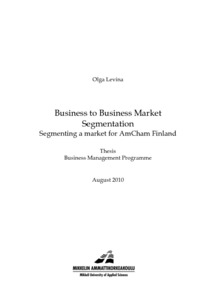Business market segmentation : Segmenting market for AmCham Finland
Levina, Olga (2010)
Levina, Olga
Mikkelin ammattikorkeakoulu
2010
All rights reserved
Julkaisun pysyvä osoite on
https://urn.fi/URN:NBN:fi:amk-2010090212848
https://urn.fi/URN:NBN:fi:amk-2010090212848
Tiivistelmä
Market of the 21st century, covering countries from all over the world, is enormously big. Products and services, presented in markets, are of very big variety. In order for companies to succeed in selling their products and services, they need to know the market they operate within, what are its characteristics and behaviour.
This thesis is concentrated on business-to-business market segmentation, or in other words industrial market segmentation, for the American Chamber of Commerce in Finland. AmCham Finland operations cover two absolutely different markets – the market of Finland and of the United States. The range of offered services is different for different customers and the customers of AmCham are quite different from each other. AmCham Finland had a strong need in analyzing its current pool of customers (member companies), and completing a market segmentation of the current member companies was considered as a solution for this need.
Market segmentation bases on macrosegmentation. The bases used for the research, are: industry; com-pany size (revenues, employees); target market; headquarters; user/non-user status; membership age. The research information was collected into one excel file, where it was post-analyzed for making possible proposals for developing AmCham Finland’s future marketing strategy.
The results of the study are considered to be trustworthy due to reliable sources of information collected for completing macrosegmentation. After segmenting the member companies into segments by industry, company size, member interaction, joining year, target market and headquarters’ location, the informa-tion was analyzed for proposing improvements for AmCham Finland’s operations. Proposals and market segmentation were based on two main factors: personal judgement and theoretical background. Am-Cham’s operations were concluded to be pretty successful, however a few services should be terminated for not being profitable and improvements in the organization’s operations and structure should be real-ized in order to better cover all market segments present at AmCham.
The study is considered to be a pretty reliable source of information for AmCham Finland, however its validity is fairly weak (6 months) due to a continuous change of economic environment and companies. Therefore a continuous collection of information is required for completing the market segmentation.
This thesis is concentrated on business-to-business market segmentation, or in other words industrial market segmentation, for the American Chamber of Commerce in Finland. AmCham Finland operations cover two absolutely different markets – the market of Finland and of the United States. The range of offered services is different for different customers and the customers of AmCham are quite different from each other. AmCham Finland had a strong need in analyzing its current pool of customers (member companies), and completing a market segmentation of the current member companies was considered as a solution for this need.
Market segmentation bases on macrosegmentation. The bases used for the research, are: industry; com-pany size (revenues, employees); target market; headquarters; user/non-user status; membership age. The research information was collected into one excel file, where it was post-analyzed for making possible proposals for developing AmCham Finland’s future marketing strategy.
The results of the study are considered to be trustworthy due to reliable sources of information collected for completing macrosegmentation. After segmenting the member companies into segments by industry, company size, member interaction, joining year, target market and headquarters’ location, the informa-tion was analyzed for proposing improvements for AmCham Finland’s operations. Proposals and market segmentation were based on two main factors: personal judgement and theoretical background. Am-Cham’s operations were concluded to be pretty successful, however a few services should be terminated for not being profitable and improvements in the organization’s operations and structure should be real-ized in order to better cover all market segments present at AmCham.
The study is considered to be a pretty reliable source of information for AmCham Finland, however its validity is fairly weak (6 months) due to a continuous change of economic environment and companies. Therefore a continuous collection of information is required for completing the market segmentation.
